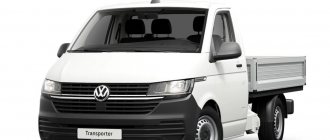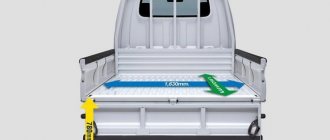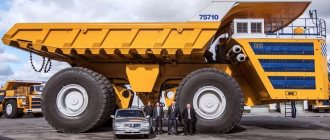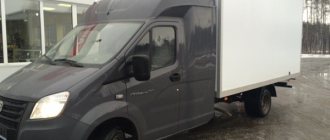ZIL-131 is a Soviet-Russian production truck, developed on the basis of the original ZIL-130 model. It is an all-terrain vehicle created by the designers of the Likhachev plant. This model replaced the Soviet ZIL-157 truck. It should be noted that most of the ZIL-131 vehicles produced were delivered to the Soviet Army. Production of ZIL-131 began in 1966 and continued until 2002. ZIL-131 exists only in all-wheel drive and with a front-engine layout. The successor to the ZIL-131 is the ZIL-4334 model. Similar models include the KrAZ-255B, as well as the Ural-4320 and Ural 375D.
ZIL-157
The production of 157 series cars at the Moscow plant began in 1958 and was produced until 1991. This model at one time won the Grand Prix at the World Auto Exhibition in Brussels. Thanks to its reliable transmission, good grip and high-quality suspension, the ZIL 157 received good reviews and recommendations. Despite the fact that the number of such machines has recently decreased noticeably, it is still too early to completely get rid of them.
| Engine | Consumption (city) | Consumption (highway) | Flow (mixed) | Type of fuel |
| 5.6 MT 109 hp (Mechanics) | — | — | 50.0 | Petrol |
Vehicles of the chemical defense troops
The ZIL-131 marked the heyday of Soviet engineering vehicles for the construction of ground structures and bridges, search and desalination of water, creation of drilling stations, means of self-excavation of trucks, accelerated mining and unique semi-floating bridges. Clutch type 24 Gearbox type 182EM 6ST-132EM Number of stages Synchronizers Transfer case type Transfer case gear ratio First stage 2.08 1 Second stage 1 1 Main gear type Double Main gear ratio 7.339 1 Rear axle drive Sequential through.
Where are ZIL-131 trucks used?
Despite the increased amount of fuel consumed, the ZIL-131 truck was specially optimized and adapted for off-road use. For this purpose, the manufacturer provides a reinforced bridge design. The tires have 8 layers and a special tread pattern. This increases and improves grip on the road surface.
Additionally, the cargo vehicle is modified with a center differential. Model 131 is different from other cars. In terms of its characteristics and parameters, it is not inferior to tracked vehicles.
In wartime, the car was installed to arm the Katyusha. This model was also used for unified normal dimensions. Advantages include the possibility of installing a covered van. It transports service stations and points for providing radio communications. Now this technique is also used at military training grounds.
The truck was used in aviation. It was equipped with equipment that made it possible to service aircraft. In urban conditions, the ZIL-131 model served as snow removal equipment. At enterprises you can find this truck as a tank for transporting oil, gasoline, and other combustion products. ZIL-131 is used in fire departments. This is the most common modification used in urban environments.
Operation and repair manual
The operating instructions contain the following sections:
- Safety rules that must be followed when operating a vehicle.
- First run-in: general rules and recommendations.
- Controls, electrical equipment connection diagrams.
- The structure of the main mechanisms: engine, transmission, body, clutch, brake system, air suspension.
- Electrical equipment.
- Malfunctions and ways to eliminate them.
- Maintenance frequency.
- Rules for storage and transportation.
The owner's manual tells you where to find the frame number. The frame number is located on the top right side of the channel.
Adjustment of valves
Valve adjustment is carried out with the power unit turned off. Before starting work, it is recommended to install the transport on the inspection hole.
The first step is to set the piston of cylinder number 1 to the highest dead center position. After installing it, turn the crankshaft 1-1.5 turns clockwise.
After the intake and exhaust valves are closed, you can begin setting the valve clearances on the ZIL-131. To do this, hold the adjusting screw with a screwdriver and loosen the tension on the locknut with a wrench.
The gap should not exceed 0.3 mm for both valves.
Then you need to repeat the procedure for the remaining seven cylinders. At the end, you need to start the engine and check the functionality of all systems.
Ignition installation
The ignition installation on this ZIL model is carried out as follows:
- Set the piston to the highest dead center position.
- Install the groove so that it is parallel to the housing of the switchgear drives.
- Rotate the crankshaft by the installation angle.
- Remove the plate mounting bolt.
- Turn on the ignition and turn the distributor housing counterclockwise.
- Tighten fasteners.
- Check that the wires are installed correctly in accordance with the operating order of the cylinders.
Change of oil
The oil change is carried out with the engine turned off and warm. Before filling, it is necessary to drain the old oil fluid, clean the drain magnet and replace the fine filter.
New oil is poured in using a funnel. After refueling, you need to let the engine run for several minutes at medium speed to fill the lubrication system. After this, it is recommended to turn off the power unit and check the oil level in the system.
ZIL design
For its time, the basic ZIL-130 was a fairly powerful car, and the fact that the ZIL 130 has such high fuel consumption per 100 km is due to this. The car has an engine equipped with 8 cylinders. All modifications of this model have power steering, as well as a 5-speed gearbox. It uses A-76 fuel for movement.
| Engine | Consumption (highway) | Consumption (city) | Consumption (mixed cycle) |
| ZIL 130 | 25 l/100 km | 35 l/100 km | 30 l/100 km |
Cost indicators
What influences high performance
Mostly, when discussing fuel consumption, it is believed that the main reason for certain indicators is the engine - power, condition, serviceability. However, the main thing that makes the ZIL 131 almost doomed to remain consistently high is the size and weight of the car
. Every experienced driver knows that every extra kilogram significantly increases the amount of liquid flammable substance required for movement. The same law applies in this case.
In addition, vehicle mileage has a fairly large impact on fuel consumption. The more kilometers of road a vehicle has already covered, the higher the likelihood that the fuel consumption of the ZIL 131 will increase.
How to find the reason?
Drivers who follow all recommendations, do not overload the vehicle, and drive calmly may also experience higher fuel levels. If such a problem occurs, you must contact a service station to check the spark gap in the spark plugs. An increase in the normal value is the most likely and common cause.
Excessive fuel consumption is also associated with a decrease in engine power level. The reason may be poor quality gasoline. When the technician has correctly set the ignition timing in the vehicle, the ignition of the fuel-air mixture occurs in a timely manner. Otherwise, detonation occurs. To fix the problem, you need to contact a good technician who has special equipment for adjusting the ignition timing.
Periodically you need to check the tightness of the starting injectors. Sometimes the sensor on a truck that shows the coolant temperature fails. If the values are incorrect, the driver may think that there is no problem. The calculation is carried out depending on the resistance of the sensor. During diagnostics, a special computer is connected to the truck, which can accurately calculate the amount of fuel.
Video
The Likhachev plant produced many modifications of the model. Among them:
- ZIL-131 – basic modification, production of which lasted from 1967 to 1986;
- ZIL-131A is a version with unshielded electrical equipment migrated from the ZIL-130. Its differences from the basic version were the absence of special military equipment, a middle bench in the body and a searchlight. Production of the car ended in 1971;
- ZIL-131V is a truck tractor built on the basis of the ZIL-131. The car had 2 spare wheels, a shortened frame and a fifth wheel coupling. The car was used to transport goods together with a semi-trailer weighing 12,000 kg (on dirt roads - 10,000 kg). Produced from 1968 to 1986;
- ZIL-131D – experimental chassis for dump trucks;
- ZIL-131D is a model with the same name and a Caterpillar engine, created in 1992. Its production lasted 2 years;
- ZIL-131N is a modernized version of the basic model. The main differences: a new ZIL-5081 engine, an increased service life (250 thousand km), an awning made of synthetic material and improved optics. Production of the ZIL-131N ended in 1987;
- ZIL-131NA – analogue of ZIL-131N with unshielded electrical equipment;
- ZIL-131NV – truck tractor with an improved platform;
- ZIL-131N1 – modification with a 105-horsepower diesel unit “D-245.20”;
- ZIL-131N2 – version with a 132-horsepower diesel unit “ZIL-0550”;
- ZIL -131S and ZIL -131AS are northern versions. These models were equipped with a cabin with an autonomous heater, frost-resistant rubber products, additional thermal insulation, fog lights, battery insulation and double glass. Cars were used in temperatures down to -60 degrees;
- ZIL-131NS, ZIL-131NAS and ZIL-131NVS - improved versions in the northern version;
- ZIL-131X - model for desert and hot areas;
- ZIL-131-137B – road train.
Qн = 0.01 x (Hsan x S + Hw x W) x (1 + 0.01 x D)
The ZIL-131 car appeared as a prototype in 1956.
After passing all the necessary tests, the truck was included in the mass production plan. The start of serial production was scheduled for 1961, but due to some problems, production had to be postponed. Initially, the truck was equipped with a V8 ZIL-130 carburetor gasoline engine with a volume of 6 liters. This 150-horsepower engine achieved a torque of 402 Nm and was equipped with a 5-speed manual transmission. There were also export versions of this truck, equipped with an imported Perkins 6.345 diesel engine producing 140 hp.
- Victor, Kyiv. I have a ZIL-130, 1986. I drove more than 100 thousand km on it and sold it. The service life of all the main components is an order of magnitude higher than indicated - we can say that the car is practically indestructible, plus instead of the standard 5-6 tons, you can safely load up to 7-9 tons. Of the minuses, I will only note the gluttony of the engine - a consumption of 35 liters is the norm, so it is better to install a diesel engine, for example D240 or 243, or the Mercedes OM366.
- Grigory, Moscow. Repairing the ZIL-130 is not a problem if you have direct hands. You can repair it in any garage, literally on your knees, but spare parts for it are becoming increasingly difficult to find. Fuel consumption is very high - in the city it is from 40 to 45 liters, but on the highway it is much less - 25 liters.
- Dmitry, Simferopol. In my twenty years of driving experience, I have not driven any trucks. In my opinion, ZIL-130 is one of the most reliable and unpretentious. Yes, it has high fuel consumption for this class - from 25 to 35 liters per 100 km, depending on the road and load, but it is completely undemanding in terms of fuel quality and pulls without problems. And of course I would like it to be more comfortable.
- Pavel, Khimki. The engine of my ZIL-130 had already been running for 300 thousand km, but at the same time I didn’t worry about the oil at all, I poured whatever was in there and at least the engine didn’t care. But 32 liters per 100 km is a lot, you need to install LPG, but you just can’t get around to doing it.
- Semyon, Kharkov. I don’t understand those drivers who neglect their cars. It is clear that Zilok 130 is reliable and unpretentious, but this does not mean that you do not need to monitor it at all. It will not break with proper care, but if you don’t take care of it, it will crumble very quickly, like any equipment. My car is from 1989 and still runs like a charm. I use good oil, regularly inspect and do maintenance, and it doesn’t break at all. But the consumption is a bit high - in the city it comes out to 32-35 liters.
- Marat, Perm. I took my 1991 ZIL-130 dump truck specifically for construction. The original engine pulled perfectly even with a load of 8,000 kg at the standard 6,000, but the consumption was like that of a cow, up to 30 liters came out. I installed a MTZ-80 diesel engine, and the consumption dropped to a maximum of 20 liters.
- Denis, St. Petersburg. My ZIL-130 has a lot of shortcomings - the power steering is capricious, there have been gaps in the box for a long time, the suspension, although it is a leaf spring, rattles, just like the cabin. But the car was produced in 1992, I have already driven 250 thousand on it. According to the passport, the consumption is 30 liters per 100 km, but this is probably only for greenhouse conditions - less than 34 liters never works out.
- Vladimir, Suzdal. I took my Zilok three years ago. The car is from 1994, but it’s peppy and drives without problems. The only problem that I can’t overcome is how to reduce gas consumption, here it is simply sky-high. In normal mode without overload, there is never less than 32 liters, and if you add 1-2 tons extra, then in general it comes out to 34 liters.
Owner reviews about fuel consumption: Vehicle history
| ZIL-130, -130A1, -130G, -130GU, -130S, -130-76, -130G-76, -130GU-76, -130S-76, -130-80, -130G-80, -130GU-80 | 31,0 | B |
| ZIL-131, -131A | 41,0 | B |
| ZIL-130, -130A1, -130G, -130GU, -130S, -130-76, -130G-76, -130GU-76, -130S-76, -130-80, -130G-80, -130GU-80 | 31,0 | B |
| ZIL-131, -131A | 41,0 | B |
| ZIL-133G, -133G1, -133G2, -133GU | 38,0 | B |
| ZIL-133GYA | 25,0 | D |
| ZIL-138 | 42,0 | CIS |
| ZIL-138A, -138AG | 32 (gasoline 31) | LNG |
| ZIL-150 | 31,0 | B |
| ZIL-151, -151A | 39,0 | B |
| ZIL-157, -157G, -157K, -157KG, -157KD, -157KE, -157KYu, -157E, -157Yu | 39,0 | B |
| ZIL-431410, -431411, -431412, -431416, -431417, -431450, -431510, -431516, -431917 | 31,0 | B |
| ZIL-431610 | 32 (31) | LNG |
| ZIL-431810 | 42,0 | CIS |
| ZIL-4331 | 25,0 | D |
| ZIL-431410 (D-243-4L-4.75-78-5M) | 19,5 | D |
| ZIL-433110 (ZIL-508.10-8V-6.0-150-5M) | 33,0 | B |
| ZIL-43317 (KAMAZ-740-8V-10.85-210-9M) | 27,0 | D |
| ZIL-433360 (ZIL-508.100040-8V-6.0-150-5M) | 31,5 | B |
| ZIL-433362 (ZIL-375-8V-7.0-175-5M) | 36,2 | B |
| ZIL-4334 (8V-8.74-159-5M) | 25,3 | D |
| ZIL-5301 (D-245 MMZ-4L-4.75-105-5M) | 14,8 | D |
| ZIL-5301 PO (Caterpillar-3054-4L-3.9-136-5M) | 15,0 | D |
| ZIL-534330 (YaMZ-236A-6V-11.15-195-5M) | 20,5 | D |
| Zil 131: technical characteristics, load capacity, fuel consumption per 100 km, military vehicle with KUNG This car was not actually a continuation of the ZIS-151 line, it was distinguished by a new transfer case, gearbox, centralized tire inflation system and other parts. It was for artillery units that in the mid-50s they began to develop the ZIS-128, which, by the way, had many similarities with the previously mentioned American M34. |
- Yuri, Novosibirsk. ZIL-130 is a very reliable car, the components and assemblies of which are designed with a large margin. The power is enough to transport cargo that exceeds the passport capacity in weight. But fuel consumption is enormous and especially increases when the car is loaded. If on the highway it is about 30-32 liters, then in the city it can easily exceed 40 or more. Model 1993 release.
- Nikita, Nizhny Novgorod. I've owned the 130 for 6 years now. What can I say - it has a spartan cabin and decent fuel consumption (about 40 liters of gasoline at best). In contrast to this is the structural strength, availability and low cost of spare parts, which is very important for the constant operation of the truck. In general, a good workhorse of the 90s with a beastly appetite.
- Grigory, Voronezh. I have extensive experience in small cargo transportation. Regarding the ZIL-130, the car is really good. In terms of maintenance, it is inexpensive, and unlike various foreign equipment, there are no problems with parts. As for fuel, you can’t travel particularly long distances on gasoline (high consumption). Whatever you say, 35 liters on the highway is too much.
- Dmitry, Moscow. ZIL-130 1989. Spacious cabin, comfortable to sit behind the wheel. A loaded car behaves well on a highway or country road, but you should be wary of roads muddy from rain. The 6-liter engine eats too much. 30-35 liters is quite noticeable for the wallet.
- Pavel, Simferopol. Due to its high maintainability, this machine can be serviced independently. Of course, there are certain disadvantages. The main one is fuel consumption, which is quite noticeable in today’s times. The average is about 33 liters. On the highway it decreases somewhat, up to 25 liters, but in the city it can exceed 40.
- Semyon, Moscow. My driving experience has exceeded twenty years. During this time I had to work on different machines. I think that the ZIL-130 truck is the most reliable Russian car. She is unpretentious and simply simple. The disadvantages include fuel consumption - 25-35 liters of gasoline per hundred, and also cabin comfort. I bought a 1987 model (mileage 210 thousand).
- Marat, Kharkov. The original 6-liter engine is unpretentious and can run more than 300,000 kilometers without repairs on not very high-quality oil. But the consumption is some kind of nightmare - from 32 and above.
- Daniil, Perm. An unpretentious and reliable car, however, it requires a caring attitude. If only it ate less fuel, but I knew what its consumption was when I bought it. As a result, 37 liters per hundred are consumed. If you add oil on time, it will last forever. Year of release: 1989.
- Vladimir, St. Petersburg. Year: 1991. Volume: 6.0. I live outside the city and needed a truck for construction. I found a modification of MMZ-554 from 1991, a dump truck. Well suited for transporting construction materials such as sand or crushed stone. But the high fuel consumption of 32 liters forced the installation of an MTZ-80 diesel engine.
- Sergey, Suzdal. All the shortcomings of the car can be attributed to its considerable age (production 1992, mileage 155 thousand). Backlash in the gearbox, the vagaries of the power steering. It requires constant attention to detail, but if you close your eyes to this, the only drawback is the high gasoline consumption, about 34 liters. I don’t know where the stated 30 liters are.
- Oleg, Krasnodar region. I bought a 1991 truck last year for work, and now I’m trying to figure out how to reduce fuel consumption by at least a couple of liters. It's a shame to fill more than 36 liters for every hundred km. Maybe you still have to replace the engine with some kind of diesel. In winter it reached 42 liters. One good thing is that even in cold weather the car does not cause serious problems. It starts well and carries a lot of cargo. On the highway it’s impossible to get less than 28 liters.
- Nikolay, Samara. For agriculture, this machine is what you need. I bought it with a mileage of 110,000 km, but it drives great for an old man born in 1989. A reliable, simple and unpretentious workhorse, except that the high fuel consumption is annoying - if you drive 40 km/h, then you can hardly meet the stated 30 liters (it turns out to be under 35). But at least the spare parts cost pennies.
Conclusion
Transport was in great demand, so it was used in all regions of the USSR. The truck was exported to Africa and Asia. Over 23 years of production, about one million cars of various modifications were produced. In 1990, production was moved to the Urals, where it continued for another 12 years, after which they began to produce an analogue of the truck under a different name.
The car continues to be used today. Its dimensions allow you to move around the city to various construction and utility sites. The ZIL-131 has never used diesel, but some owners install diesel engines themselves to reduce fuel costs.
On the secondary market, such a truck from 90-91 can be bought for 100-110 thousand rubles. “Young” copies of the early 2000s will cost the buyer 350-400 thousand. The final price tag depends on the external and technical condition of the vehicle. Some owners rent out ZiLs. The average price is 1000 rubles per hour.
Device
The power unit of the car is located under the hood. The cabin is all-metal and accommodates two passengers and a driver. The driver and passengers seats are separate. The driver can adjust his seat in horizontal and vertical planes, as well as adjust the backrest tilt.
The ZIL-131 cabin was copied from the civilian 130 version - but the soldiers did not like it. After several batches were produced, it was replaced with a cabin from the ZIL-165. The car turned out to be more comfortable, the windshield became panoramic, it now consisted of two parts and provided a wide view.
ZIL-131 was similar to other domestic off-road trucks. Its main competitors were the Ural-375 and ZIL-157K. The similarity of these machines is explained by the uniform Soviet standard in force when designing such equipment. Differences could be noticed in some components and in different approaches to production.
For many years, engineers have been trying to solve a difficult problem: how to reduce the cost of a car and not lose a high level of performance characteristics? As a result, the problem was resolved, resulting in the birth of a high-quality, reliable product. After the release of the 131st, they planned to curtail the production of the 157th, however, they were produced in parallel for the next 20 years.










